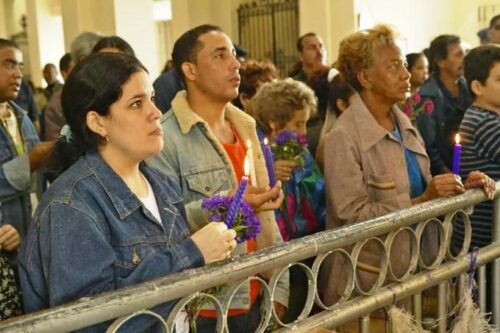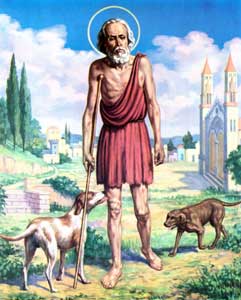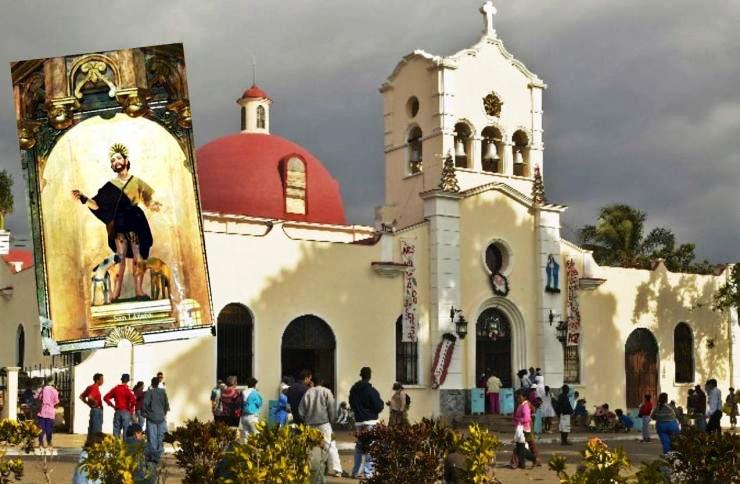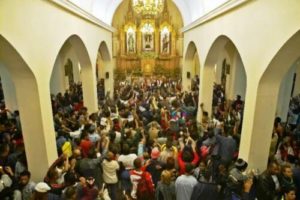SAN LÁZARO, EL VIEJO SANTO CUBANO Y SU DEVOCIÓN DEL PUEBLO. FOTOS
Cada año miles de personas acuden a rendir homenaje a San Lázaro en El Rincón, a pocos kilómetros de la capital La Habana. “Solo los cubanos conocen los misterios que esconde San Lázaro”.
Los peregrinos llegan sin aliento arrastrándose de rodillas por el camino que conduce al Santuario Nacional dedicado a San Lázaro en El Rincón. El lugar se llena de devotos que rinden homenaje a San Lázaro, el santo de los pobres, el sanador de las enfermedades de la piel. Este anciano milagroso es amado tanto como Nuestra Señora de la Caridad del Cobre, la santa patrona de Cuba.
Cada 17 de diciembre, día del homenaje al santo, una numerosa multitud se concentra en la pequeña localidad de El Rincón, a unos 15 kilómetros del centro de La Habana, ya sea para cumplir promesas por las gracias obtenidas o para pedir al santo salud, dinero y el amor, elementos esenciales, según muchos, para alcanzar la felicidad.
Personas en sus ofrendas y ceremonia religiosa en su Iglesia en El Rincón.
Venerado en toda Cuba, este santo es representado como un anciano con llagas en el cuerpo, vestido con harapos, con muletas, acompañado de dos perritos que, según la leyenda, le lamían las heridas para calmar el dolor. No es muy fácil llegar a El Rincón, un pequeño pueblo del municipio de Rancho Boyeros. Sin embargo, especialmente, el 17 de diciembre, se puede ver una gran multitud de peregrinos caminando por el camino que conduce a las puertas del lugar sagrado. Algunos llegan sin aliento arrastrándose de rodillas o de espaldas, algunos incluso arrastrando piedras desde el centro de La Habana para cumplir las promesas hechas a San Lázaro. Los miembros de la Cruz Roja están allí, listos para acudir en ayuda de aquellos que están cansados o desmayados.
El culto a San Lázaro pasa de generación en generación, unos lo identifican como el Lázaro de la Biblia, otros como el mendigo que aparece en una parábola del Evangelio, y aún otros como Babalu Aye, orisha (deidad) de la religión yoruba desde Dahomey, en África. El culto a San Lázaro es, por lo tanto, también un ejemplo de devoción sincrética: los esclavos africanos mantuvieron vivas sus antiguas religiones “sincretizando” sus deidades con los santos cristianos. La procesión en honor al Viejo, como llaman cariñosamente al santo, puede llegar a tener varios kilómetros. Algunos devotos caminan descalzos; otros llevan una gran cruz de madera a la espalda; algunos atan una piedra a una cadena alrededor de sus tobillos. No hay distinción de sexo o raza entre los devotos de San Lázaro.
Es sin duda, el 17 de diciembre, fecha oficial del homenaje al santo, el que mayor afluencia de público acude al recinto sagrado de El Rincón. Sin embargo, esta iglesia, dedicada al culto de San Lázaro, es visitada durante todo el año. Todos los días una gran cantidad de personas acuden al santuario trayendo a sus niños pequeños, a sus abuelos y hasta a sus cachorros para que sean bendecidos por un sacerdote. Este santuario fue construido en 1917 como Iglesia de San Lázaro y hospital-hogar para enfermos de lepra. En la década de los noventa del siglo XX, esta pequeña iglesia fue galardonada con el título de Santuario Nacional.
En 1998 el Papa Juan Pablo II fue a visitar el santuario y celebró una misa tal como lo hizo en Santiago de Cuba cuando ofició una misa en el santuario de la Virgen de la Caridad del Cobre, como parte de su visita pastoral.
El santuario se mantuvo sin cambios hasta 1990, cuando se agregaron dos pasillos laterales para hacer más espacio y acomodar a más fieles. Todo el edificio fue restaurado y, a pesar de que la estructura actual no tiene un estilo arquitectónico definido, recuerda a una iglesia de inspiración colonial-barroca. El interior es más bien modesto: el altar mayor también muestra elementos neoclásicos y románticos que conforman un conjunto ecléctico típicamente cubano. Otros altares más pequeños se caracterizan por elementos neogóticos y están dedicados, entre otros, a la Virgen de la Caridad ya la Virgen de Regla.
Iglesia Católica San Lázaro El Rincón y visitantes
En la bóveda central se puede contemplar una gigantesca figura de San Lázaro ricamente vestido y, a su izquierda, otra imagen más pequeña del santo, protegida por un cristal, donde se representa a San Lázaro como el ‘milagroso’ parcialmente vestido. ‘ anciano. Los fieles rezan de pie ante la imagen del santo. También hacen ofrendas, encienden velas y dejan ramos de flores moradas, el color del santo, que los asistentes depositan en grandes cestas.
San Lázaro …ya sea el Lázaro bíblico resucitado, o San Lázaro el ‘viejo milagroso’, o el Babalú afrocubano Aye, más allá de creencias y milagros, concedidos o no, fanatismo o tradición, este santo forma parte de los cubanos. ‘ cultura. Estas personas encuentran fuerza, resistencia, humildad y amor en su fe religiosa. Solo los cubanos conocen los misterios que esconde San Lázaro, solo los cubanos conocen los supuestos milagros concedidos a ellos, oa sus seres queridos. Una de las características de estas procesiones, a pesar de estar masificadas, es el silencio.
Sólo hay uno con quien hablar y orar: este santo. Y una vez que las personas dejen atrás las puertas del lugar sagrado, sean creyentes o no, sus almas ciertamente se sentirán en paz. Se sentirán agradecidos por algo que ni siquiera pueden definir. No saben explicar por qué… pero se sienten en paz con su conciencia.
SAN LAZARO, THE OLD CUBAN SAINT AND HIS DEVOTION OF THE PEOPLE. PHOTOS
Every year thousands of people go to pay homage to Saint Lazarus in El Rincón, a few kilometres from the capital Havana. “Only Cubans know the mysteries that Saint Lazarus hides”.
Pilgrims arrive breathless crawling on their knees along the path that leads to the National Sanctuary dedicated to Saint Lazarus in El Rincón. The place is packed with devotees paying homage to Saint Lazarus, the saint of the poor, the healer of the diseases of the skin. This miraculous old man is loved as much as Our Lady of Charity of El Cobre, the patroness saint of Cuba.
Every 17 December, the day of homage to the saint, a vast crowd gathers at the small town of El Rincón, about 15 kilometres from the centre of Havana, either to honour promises for graces they obtained or to ask the saint for health, money and love, essential elements, according to many, to achieve happiness.
People in theirs offerings and religious ceremony at his Church in El Rincon.
Revered throughout Cuba, this saint is represented as an old man with sores on his body, wearing rags, with crutches, accompanied by two small dogs which, according to legend, licked his wounds to soothe the pain. It is not very easy to reach El Rincón, a small town in the municipality of Rancho Boyeros. However, especially, on the 17th of December, one can see a vast crowd of pilgrims walking along the path that leads to the gates of the sacred site. Some arrive breathless crawling on their knees or on their backs, some even dragging rocks behind them all the way from central Havana to honour promises made to St Lazarus. Red Cross members are there, ready to come to the aid of those who are tired or pass out.
The cult of Saint Lazarus passes from generation to generation, some identify him as the Lazarus in the Bible, others as the beggar who appears in a parable of the Gospel, and still others as Babalu Aye, orisha (deity) of the Yoruba religion from Dahomey, in Africa. The cult of Saint Lazarus is therefore also an example of syncretic devotion: African slaves kept their old religions alive by ‘syncretizing’ their deities with Christian saints. The procession in honour of the Old man, as people affectionately call the saint, can be several kilometres long. Some devotees walk barefoot; others carry a large wooden cross on their backs; some tie a stone to a chain around their ankles. There is no distinction of sex or race among Saint Lazarus’ devotees.
It is without a doubt, the 17th of December, the official date of tribute to the saint, sees the largest volumes of people at the sacred site in El Rincón. However, this church, dedicated to the cult of Saint Lazarus, is visited all year round. Every day a huge number of people go to the sanctuary bringing their little children, their grandparents and even their puppies to have them blessed by a priest. This shrine was built in 1917 as the Saint Lazarus Church and home-hospital for leprosy patients. In the nineties of the twentieth century, this small church was awarded the title of National Sanctuary.
In 1998 Pope John Paul II went to visit the shrine and celebrated a mass just as he did in Santiago de Cuba when he held a mass at the shrine of the Virgen de la Caridad del Cobre, as part of his pastoral visit.
The sanctuary remained unchanged until 1990, when two side aisles were added to make more space in order to accommodate more faithful. The whole building was restored, and despite the fact that the current structure does not have a defined architectural style it reminds one of a Colonial-Baroque-inspired church. The interior is rather modest: the main altar also shows neoclassical and romantic elements that make up a typically Cuban eclectic ensemble. Other smaller altars are characterized by neo-Gothic features and are dedicated, among others, to the Virgen de la Caridad and the Virgen de Regla.
San Lazaro El Rincon Catholic Church and visitors
In the central vault, visitors can see a gigantic figure of a richly-dressed Saint Lazarus and, to its left, another smaller image of the saint, which is protected by a glass, where Saint Lazarus is represented as the partially-dressed ‘miraculous’ old man. The faithful stand praying before the image of the saint. They also make offerings, light candles and leave bouquets of purple flowers, the colour of the saint, which are placed in large baskets by attendants.
Saint Lazarus …whether the Biblical Lazarus raised from the dead, or Saint Lazarus the ‘miraculous old man’, or the Afro-Cuban Babalu Aye, beyond beliefs and miracles, whether granted or not, fanaticism or tradition, this saint is part of Cubans’ culture. These people find strength, resistance, humility and love in their religious faith. Only Cubans know the mysteries that Saint Lazarus hides, only Cubans know about the alleged miracles granted to them, or to their dear ones. One of the characteristics of these processions, despite being overcrowded, is silence.
There is only one to talk to and to pray: this saint. And once people leave the gates of the sacred site behind, whether they are believers or not, their souls will certainly feel at peace. They will feel grateful for something they cannot even define. They can’t explain why… but they feel at peace with their conscience.
Agencies/ WIki/ SouthWorld/ SanLazaroHis./ Extractos/ Excerpts/ Internet Photos/ Arnoldo Varona/ www.TheCubanHistory.com
THE CUBAN HISTORY, HOLLYWOOD.



 SAN LAZARO, the Old Cuban Saint and His Devotion of the People. PHOTOS. * SAN LÁZARO, el Viejo Santo Cubano y su Devoción del Pueblo. FOTOS.
SAN LAZARO, the Old Cuban Saint and His Devotion of the People. PHOTOS. * SAN LÁZARO, el Viejo Santo Cubano y su Devoción del Pueblo. FOTOS.








